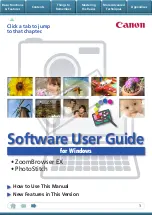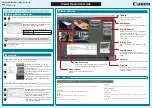
ExtremeWare XOS 11.3 Concepts Guide
515
24
IPv6 Unicast Routing
This chapter covers the following topics:
This chapter describes the following topics:
●
Overview of IPv6 Unicast Routing on page 515
●
Router Interfaces on page 516
●
Specifying IPv6 Addresses on page 516
●
Neighbor Discovery Protocol on page 518
●
Populating the Routing Table on page 519
●
Configuring IP Unicast Routing on page 522
●
Verifying the IP Unicast Routing Configuration on page 522
●
Routing Configuration Example on page 522
This chapter assumes that you are already familiar with IPv6 unicast routing. If not, refer to the
following publications for additional information:
●
RFC 2460—
Internet Protocol, Version 6 (IPv6) Specification
●
RFC 3513—
Internet Protocol Version 6 (IPv6) Addressing Architecture
NOTE
For more information on interior gateway protocols, see
Chapter 26
,
RIPng
or
Chapter 28
,
OSPFv3
.
Overview of IPv6 Unicast Routing
The switch provides full Layer 3, IPv6 unicast routing. It exchanges routing information with other
routers on the network using either the IPv6 version of Routing Information Protocol (RIPng) or the
IPv6 version of Open Shortest Path First (OSPFv3) protocol. The switch dynamically builds and
maintains a routing table and determines the best path for each of its routes.
Beginning in release 11.2, ExtremeWare XOS can provide both IPv4 and IPv6 routing at the same time.
Separate routing tables are maintained for the two protocols. Most commands that require you to
specify an IP address can now accept either an IPv4 or IPv6 address and act accordingly. Additionally,
many of the IP configuration, enabling, and display commands have added tokens for IPv4 and IPv6 to
clarify the version required. For simplicity, existing commands affect IPv4 by default and require you to
specify IPv6, so configurations from an earlier release will still correctly configure an IPv4 network.
ACLs and routing policies also support IPv6. Use an IPv6 address in a rule entry will automatically use
IPv6.
NOTE
IPv6 functionality is supported only on the virtual routers VR-Default and VR-Mgmt. VR-Mgmt supports only IPv6
addressing and static routing; VR-Default also supports dynamic routing.
Summary of Contents for ExtremeWare XOS 11.3
Page 20: ...Contents ExtremeWare XOS 11 3 Concepts Guide 20...
Page 25: ...1 Using ExtremeWare XOS...
Page 26: ......
Page 38: ...ExtremeWare XOS Overview ExtremeWare XOS 11 3 Concepts Guide 38...
Page 58: ...Accessing the Switch ExtremeWare XOS 11 3 Concepts Guide 58...
Page 146: ...Configuring Slots and Ports on a Switch ExtremeWare XOS 11 3 Concepts Guide 146...
Page 218: ...Status Monitoring and Statistics ExtremeWare XOS 11 3 Concepts Guide 218...
Page 240: ...Virtual LANs ExtremeWare XOS 11 3 Concepts Guide 240...
Page 248: ...Virtual Routers ExtremeWare XOS 11 3 Concepts Guide 248...
Page 278: ...Access Lists ACLs ExtremeWare XOS 11 3 Concepts Guide 278...
Page 288: ...Routing Policies ExtremeWare XOS 11 3 Concepts Guide 288 entry deny_rest if then deny...
Page 344: ...Security ExtremeWare XOS 11 3 Concepts Guide 344...
Page 393: ...2 Using Switching and Routing Protocols...
Page 394: ......
Page 454: ...Spanning Tree Protocol ExtremeWare XOS 11 3 Concepts Guide 454...
Page 484: ...Extreme Standby Router Protocol ExtremeWare XOS 11 3 Concepts Guide 484...
Page 514: ...IPv4 Unicast Routing ExtremeWare XOS 11 3 Concepts Guide 514...
Page 530: ...IPv6 Unicast Routing ExtremeWare XOS 11 3 Concepts Guide 530...
Page 538: ...RIP ExtremeWare XOS 11 3 Concepts Guide 538...
Page 556: ...OSPF ExtremeWare XOS 11 3 Concepts Guide 556...
Page 566: ...OSPFv3 ExtremeWare XOS 11 3 Concepts Guide 566...
Page 589: ...3 Appendixes...
Page 590: ......
Page 640: ...CNA Agent ExtremeWare XOS 11 3 Concepts Guide 640...
Page 670: ...Glossary ExtremeWare XOS 11 3 Concepts Guide 670...
Page 698: ...Index ExtremeWare XOS 11 3 Concepts Guide 698...
















































